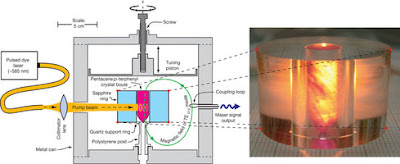

| Visitors Now: | |
| Total Visits: | |
| Total Stories: |

| Story Views | |
| Now: | |
| Last Hour: | |
| Last 24 Hours: | |
| Total: | |
Room-temperature solid-state maser
From
Nature – The invention of the laser has resulted in many innovations, and the device has become ubiquitous. However, the maser, which amplifies microwave radiation rather than visible light, has not had as large an impact, despite being instrumental in the laser’s birth. The maser’s relative obscurity has mainly been due to the inconvenience of the operating conditions needed for its various realizations: atomic and free-electron masers require vacuum chambers and pumping; and solid-state masers, although they excel as low-noise amplifiers and are occasionally incorporated in ultrastable oscillators typically require cryogenic refrigeration. Most realizations of masers also require strong magnets, magnetic shielding or both. Overcoming these various obstacles would pave the way for improvements such as more-sensitive chemical assays, more-precise determinations of biomolecular structure and function, and more-accurate medical diagnostics (including tomography) based on enhanced magnetic resonance spectrometers incorporating maser amplifiers and oscillators. Here we report the experimental demonstration of a solid-state maser operating at room temperature in pulsed mode. It works on a laboratory bench, in air, in the terrestrial magnetic field and amplifies at around 1.45 gigahertz. In contrast to the cryogenic ruby maser, in our maser the gain medium is an organic mixed molecular crystal, p-terphenyl doped with pentacene, the latter being photo-excited by yellow light. The maser’s pumping mechanism exploits spin-selective molecular intersystem crossing10 into pentacene’s triplet ground state. When configured as an oscillator, the solid-state maser’s measured output power of around −10 decibel milliwatts is approximately 100 million times greater than that of an atomic hydrogen maser, which oscillates at a similar frequency (about 1.42 gigahertz). By exploiting the high levels of spin polarization readily generated by intersystem crossing in photo-excited pentacene and other aromatic molecules, this new type of maser seems to be capable of amplifying with a residual noise temperature far below room temperature.
Anatomy of the maser. A crystal of p-terphenyl doped with pentacene is located in the a.c. magnetic field of the TE01δ mode of a microwave resonator and illuminated with a beam of yellow light from a pulsed dye laser.
Discover Magazine 80 beats has coverage
Lasers and masers work on the same principle, amplifying light through a process called stimulated emission, except that lasers amplify visible light while masers act on microwaves. Light and microwaves are both forms of electromagnetic radiation, but microwaves have a wavelength 100,000 times greater than that of visible light. But although the maser has been used for deep-space communications and atomic clocks, lasers have always outshone their predecessors.
While the room-temperature maser is currently a solution with few applications, it may rise to prominence for its amplifying ability. Amplifiers are a vital component in any electronic circuit. The lower their noise, the better amplifiers perform—and masers have very little noise.
See more and subscribe to NextBigFuture at 2012-08-15 15:49:43 Source: http://nextbigfuture.com/2012/08/room-temperature-solid-state-maser.html
Source:



